Agricultural Population
Central Visayas recorded about 1.96 million individuals aged 18 and above who were members of households with at least one agricultural operator from 01 January to 31 December 2022 referred to as agricultural population. Out of the total agricultural population, approximately 1.00 million or 51.0 percent are males, while 962 thousand or 49.0 percent are females.
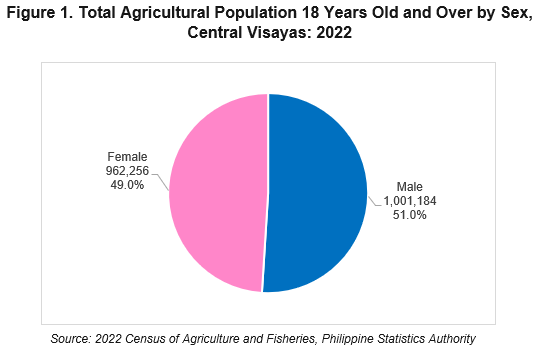
Among the provinces in the region, Bohol had the highest share with 817.72 thousand agricultural population or 41.6 percent of the total, followed by Negros Oriental with 541.28 thousand and Cebu with 521.06 thousand agricultural population. Siquijor recorded the least with 44.39 thousand individuals. In contrast, highly urbanized cities had significantly lower agricultural populations, with City of Cebu at 21.02 thousand individuals, City of Lapu-Lapu with 15.45 thousand individuals, and City of Mandaue with 2.54 thousand individuals.
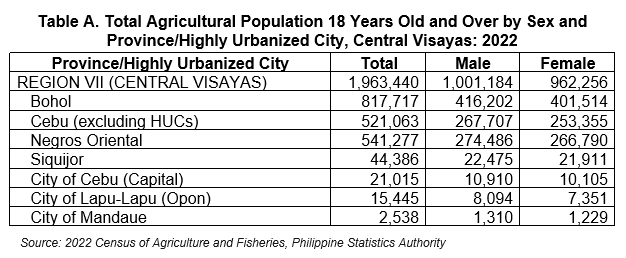
Agricultural Population with Ownership or Secure Rights over Agricultural Land
Of the total agricultural population in Central Visayas, individuals who reported owning or having secure rights over their agricultural land accounted for 23.3 percent or 457.93 thousand. Of this, approximately 282.56 thousand or 61.7 percent, are males, while 175.37 thousand or 38.3 percent are female. (Table C)
Among the provinces and highly urbanized cities of the region, Siquijor stood out with the highest proportion of its agricultural population 18 years old and over (28.4%) holding ownership or secure rights over agricultural land. This reflects the province’s strong emphasis on land ownership, which aligns with its cultural and historical practices. Negros Oriental (26.3%) and Bohol (23.5%) are also notable for having higher-than-regional average proportions of their agricultural population with secure rights over agricultural land.
On the other hand, City of Lapu-Lapu (4.1%) had the lowest proportion of agricultural population with secure land rights in 2022. (Table B)
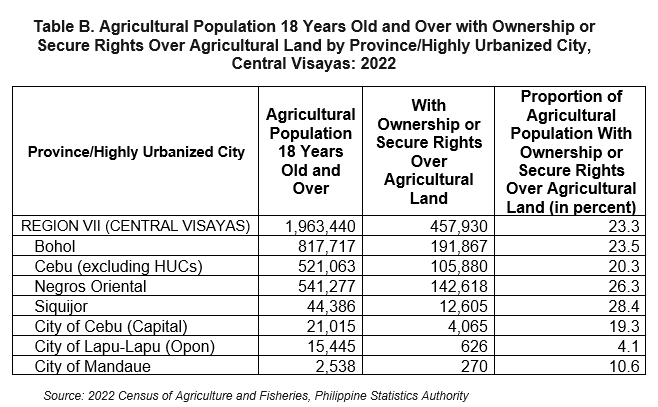
Among male agricultural population, 282.56 thousand (28.2%) hold secure rights over agricultural land. Meanwhile, only 175.37 thousand (18.2%) of the female agricultural population have ownership or secure rights. This highlights a significant gender disparity, with women being 10 percentage points lower than men to own or have secure rights to agricultural land. (Table C)
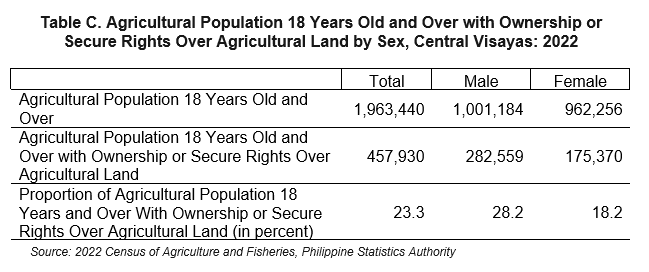
Further, males significantly outnumbered females across all provinces and highly urbanized cities. Among females, Siquijor recorded the highest proportion of agricultural landowners and right bearers (26.8%), followed by Negros Oriental at 21.1 percent and Bohol at 17.1 percent. These provinces exhibit comparatively stronger representation of women in agricultural land ownership than other provinces and highly urbanized cities of the region. On the other hand, City of Lapu-Lapu (3.8%) had the lowest proportions of agricultural land ownership among the female agricultural population. (Figure 2)
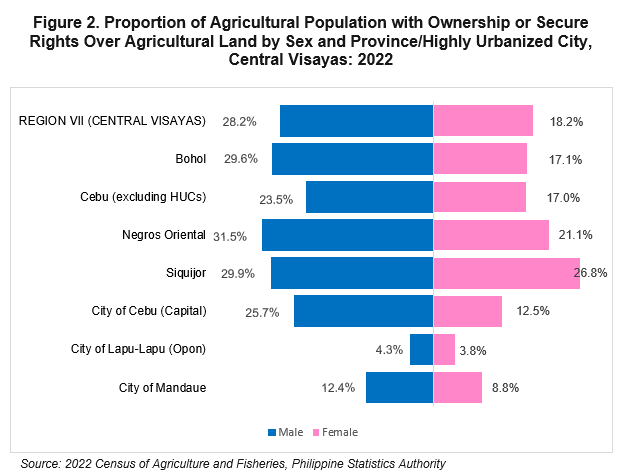
Bohol recorded the largest agricultural population with land ownership or secure rights, totaling 191,867 individuals. Negros Oriental ranked second with 142,618 individuals, followed by Cebu, with 105,880 individuals. (Table B)
During the same reference period, approximately 177.72 thousand members of the agricultural population aged 18 and over reported full ownership of their agricultural land, meaning they held a formal title of ownership. Of these, 106.17 thousand (59.7%) were males, while 71.55 thousand (40.3%) were females. Bohol led in female full ownership of agricultural land, with 43.1 percent, followed by Negros Oriental with
29.0 percent. (Table D and Figure 3)
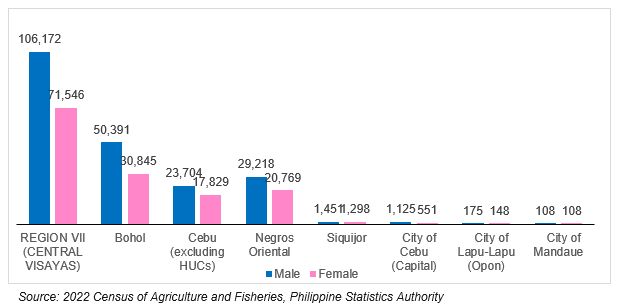
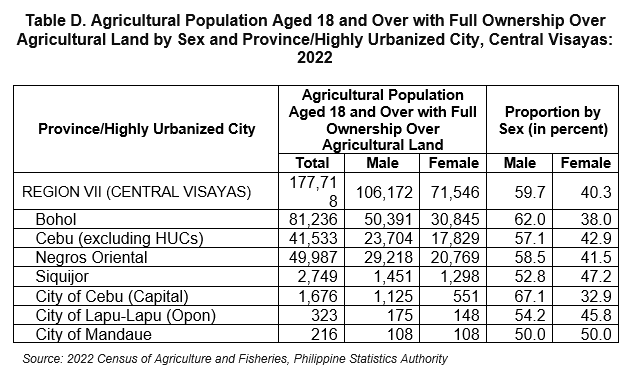
On the other hand, about 217.31 thousand individuals had owner-like possession over agricultural land, comprising 132.84 thousand (61.1%) males and 84.46 thousand (38.9%) females. (Table E and Figure 4)
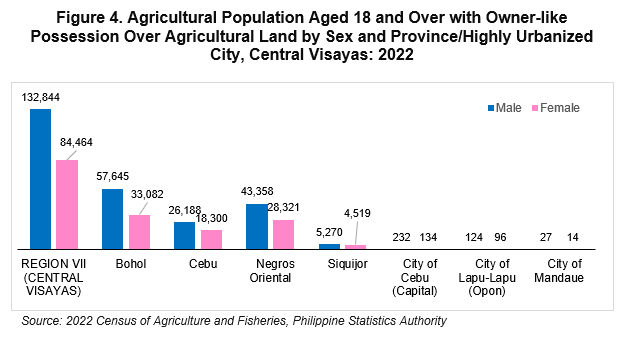

Among the provinces and highly urbanized cities of Central Visayas, Bohol led in agricultural population with owner-like possession over agricultural land, reporting 90,727 individuals. Negros Oriental ranked second with 71,678 individuals and Cebu followed with 44,488 individuals. In these top three provinces, the share of women among those with owner-like possession of agricultural land exceeds one-third, 36.5 percent, 39.5 percent, and 41.1 percent respectively. (Table E)
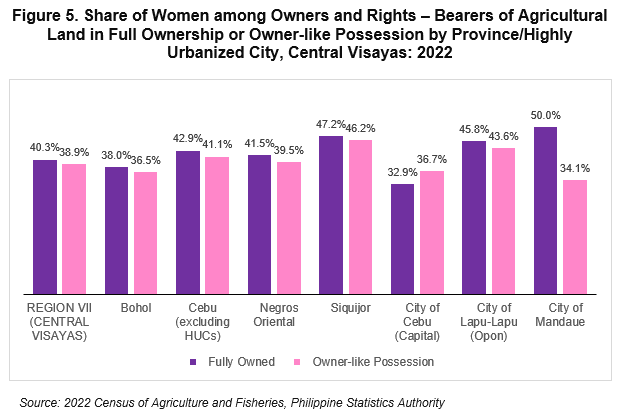
Households with Agricultural Operators
The number of agricultural households or households with at least one agricultural operator, that is, with crop, livestock and/or poultry operators, reached 694 thousand. Among the total number of agricultural households, 189 thousand (27.2%) were households with operators engaged in crop farming activities only, and 112 thousand (16.1%) were households with operators engaged in livestock and/or poultry farming activities only, and 394 thousand (56.7%) were households with operators engaged in both crop and livestock and poultry farming activities.
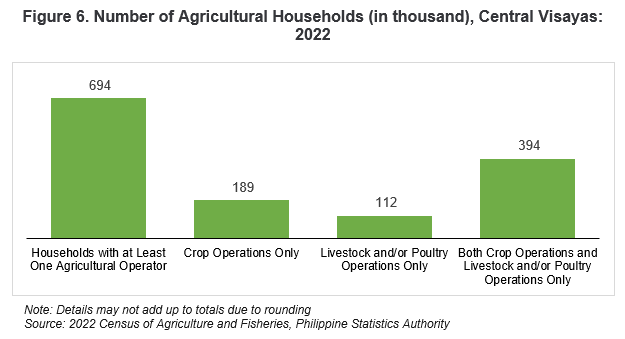
Among the provinces and highly urbanized cities in the region, Bohol had the highest number of households with at least one agricultural operator with 280.21 thousand. It also recorded the largest number of households engaged exclusively in crop cultivation at 81.01 thousand, while Cebu had the highest number of households solely dedicated to raising livestock and/or poultry at 48.70 thousand.
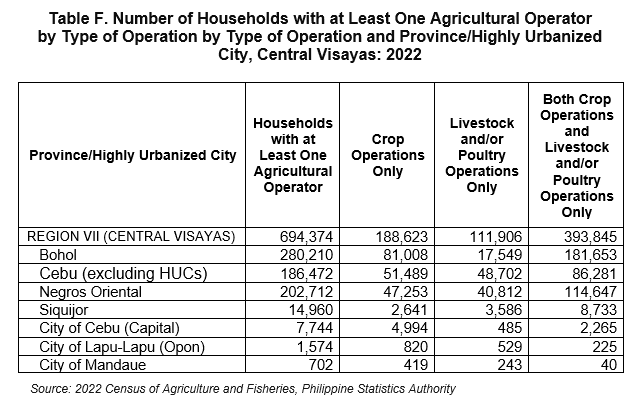
The number of agricultural operators in the year 2022 in the region recorded at 719.45 thousand. More than half (58.0%) of agricultural operators were engaged both in crop farm and livestock and/or poultry farm activities, while 26.4 percent were operators exclusively in crop farming (crop farm operators only), and only 15.6 percent operators raised livestock and/or poultry animals only.
Among the provinces and highly urbanized cities in the region, Bohol had the highest number of agricultural operators at 294.82 thousand. It also recorded the largest number of operators engaged exclusively in crop farming at 82.29 thousand, as well as those involved in both crop farming and livestock and/or poultry farming at 194.93 thousand. Meanwhile, Cebu had the highest number of agricultural operators dedicated solely to raising livestock and/or poultry at 48.90 thousand.
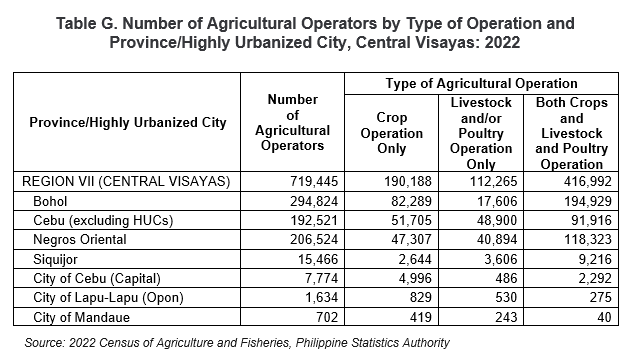
Of the total 719.45 thousand agricultural operators in 2022, 509.73 thousand (70.9%) were males while 209.71 thousand (29.1%) were females. This translated into a ratio of about 243 male agricultural operators for every 100 female agricultural operators.
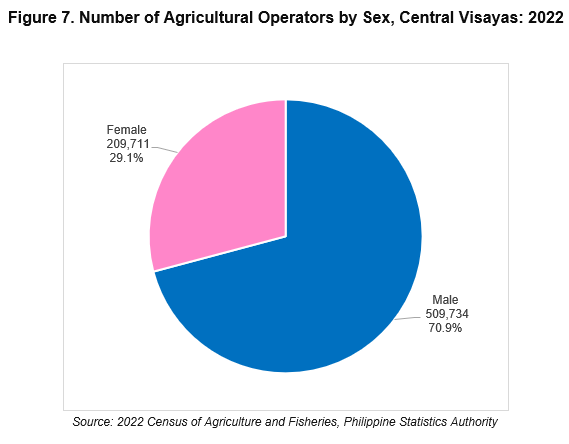
Among provinces, Bohol recorded the highest number of female agricultural operators at 79,362, representing 26.9 percent of the province’s total. Negros Oriental followed with 56,199 female operators (27.2%), while Cebu had 66,220 female operators (34.4%), the highest proportion among the three major provinces. Siquijor recorded 4,836 female agricultural operators (31.3%), showing a relatively higher female participation compared to other provinces.
Among the highly urbanized cities, City of Cebu had 1,975 female agricultural operators (25.4%), while City of Lapu-Lapu recorded 741 (45.3%), reflecting a more balanced gender distribution. City of Mandaue stood out as the only area where female agricultural operators (378) outnumbered males, comprising 53.8 percent of its total agricultural operators.
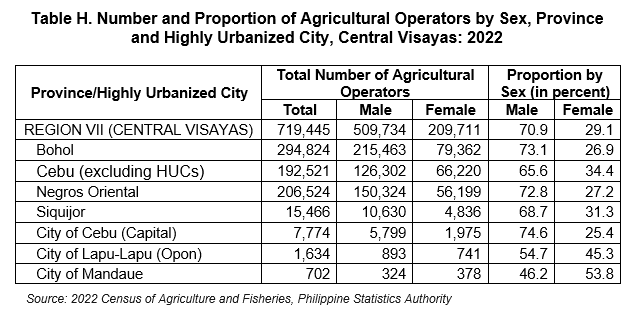
Fishing Households and Operators
In 2022, the number of households with fishing operators in Central Visayas was recorded at 93.63 thousand, while the total number of fishing operators reached 96.49 thousand. Among the provinces and highly urbanized cities, Bohol had the highest number of fishing households (44.21 thousand) and fishing operators (45.84 thousand). Cebu ranked second, with 30.64 thousand fishing households and 31.52 thousand fishing operators, followed by Negros Oriental with 10.86 thousand fishing households and 11.07 thousand fishing operators. Meanwhile, City of Mandaue recorded the lowest figures, with only 27 fishing households and 27 fishing operators.
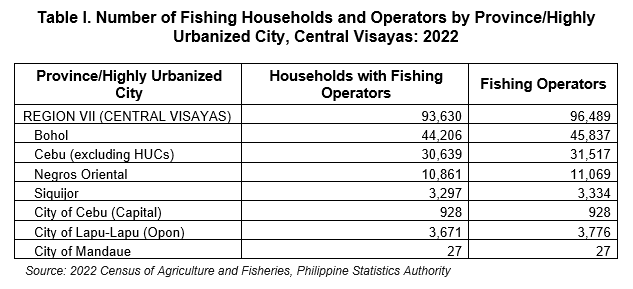
In 2022, majority of the fishing operators in Central Visayas were males, accounting for 87,302 out of 96,489 fishing operators (90.5%), while females represented 9,187 fishing operators or 9.5 percent.
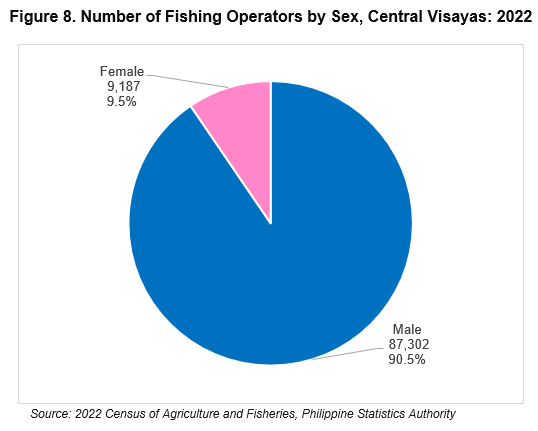
Among the provinces, Bohol reported the highest number of fishing operators, with 41,008 males and 4,830 females. Cebu followed with 27,917 males and 3,600 females, while Negros Oriental had 10,491 males and 578 females. Siquijor, the province with the smallest fishing sector, registered 3,256 male operators and only 79 female operators.
In terms of highly urbanized cities, the City of Cebu (Capital) had 920 male fishing operators and a mere 8 females. The City of Lapu-Lapu (Opon) recorded 3,684 males and 92 females, while the City of Mandaue had 27 males and no reported female operators.
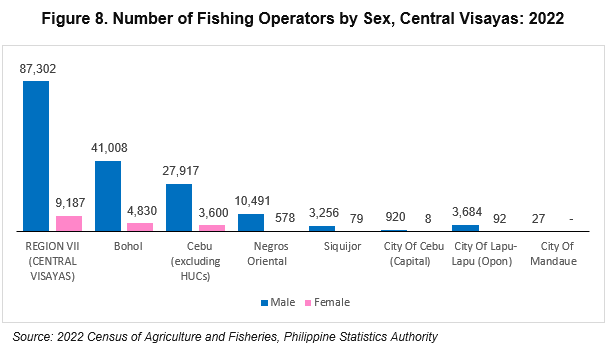
TECHNICAL NOTES
Household
A household is a social unit consisting of a person or a group of persons who sleep in the same housing unit and have a common arrangement in preparing and consuming food.
Agricultural Population
Agricultural Population refers to the members of the household engaged in operating agricultural activities or the household with at least one member engaged in operating agricultural activities during a specific reference period.
Agricultural populations with ownership or secure rights
Agricultural populations with ownership or secure rights over agricultural land/parcel refer to the adult members of agricultural households aged 18 years old and over, who own or are rights-bearers of agricultural land/parcel used in operating agricultural activities during a specific reference period.
Agricultural Operator
An agricultural operator is a civil or juridical person who/that exercises management control over the agricultural operation of a farm and takes major decisions regarding resource use. He/she has technical and economic responsibility for the farm and may undertake all responsibilities directly, that is, he/she operates the farm or delegates responsibilities related to day-to-day work management to a hired manager. Economic responsibility means a major decision in using the finances in operating the farm.
An agricultural operator could be the owner or tenant/lessee of the farm who is solely responsible for making the major decisions of the operation of the agricultural farm, including the management and supervision of hired labor.
Approved by:
(SGD.)
WILMA A. PERANTE
(Director II)
Officer-in-Charge

